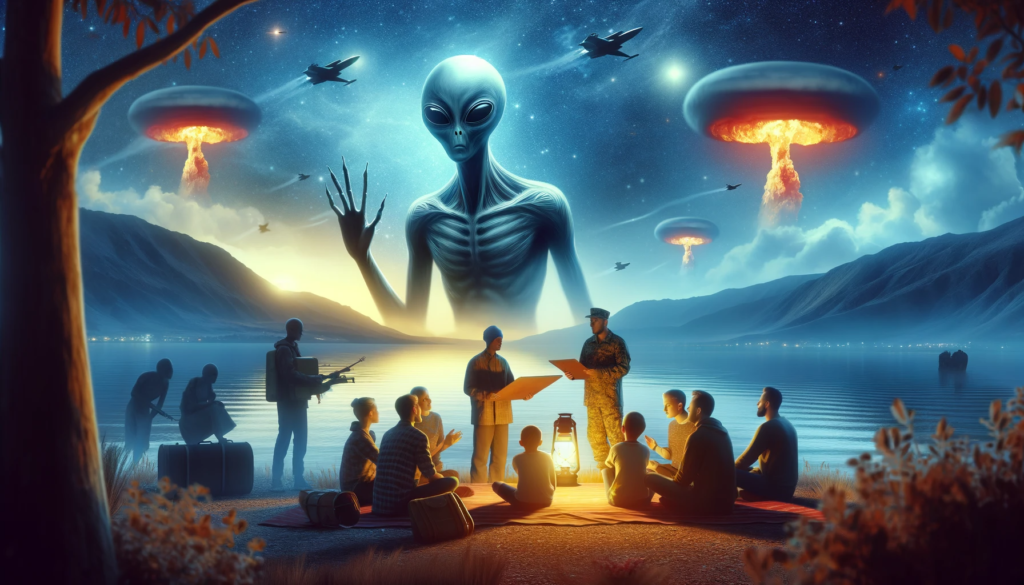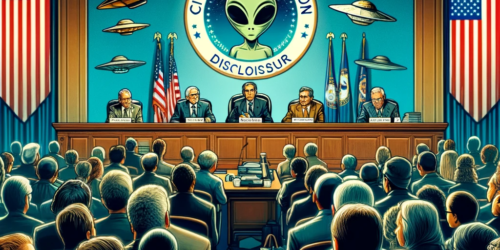Nuclear War

War has been a frequent and often tragic part of human history, underscoring the importance of peace-building and conflict resolution efforts in the modern world. It is estimated that there has been over 1,000 wars in just 2,000 years.
The phenomenon of contactees receiving messages about nuclear war from extraterrestrial beings is a recurring theme in UFO reports. These stories often involve individuals claiming to have direct communication with alien entities, who warn of the dangers of nuclear weapons and the potential for nuclear war. Here are several notable examples:
- George Adamski (1950s): George Adamski was among the most famous early UFO contactees. He claimed to have met with friendly aliens, including one named Orthon from Venus. Adamski’s extraterrestrial contacts allegedly warned him about the dangers of nuclear war and the need for humanity to pursue peace and disarmament.
- Eduard “Billy” Meier (1975 – Present): Swiss contactee Billy Meier has claimed ongoing contact with extraterrestrial beings from the Pleiades star cluster. According to Meier, his alien contacts, particularly one named Semjase, have provided him with messages warning of the dangers of nuclear war and the need for humanity to change its path.
- Robert Salas (1967): Robert Salas, a former U.S. Air Force officer, reported a UFO encounter at Malmstrom AFB, where he was on duty during a missile shutdown incident. Years later, Salas publicly spoke about his belief that the UFO was sending a message about the dangers of nuclear weapons, implying a warning against nuclear war.
- Howard Menger (1950s-1960s): Howard Menger, an American contactee, claimed to have regular contacts with extraterrestrials. He reported that these beings warned him about the dangers of nuclear weapons and the potential for a catastrophic war, urging humanity to pursue peace.
- Daniel Fry (1950s): An American contactee, Daniel Fry claimed to have been taken aboard a UFO and given a tour by an extraterrestrial named A-lan. Fry reported that A-lan warned him about the destructive path humanity was on, including the dangers of nuclear war.
- Orfeo Angelucci (1950s): Orfeo Angelucci was another prominent contactee who claimed to have communicated with extraterrestrials. His alien contacts allegedly warned him about the existential threat of nuclear weapons and the need for human spiritual advancement to avoid catastrophe.
- George King (1950s): George King, founder of the Aetherius Society, claimed to be in contact with extraterrestrial intelligences, including a being he called “Aetherius.” These beings purportedly conveyed messages about the importance of spiritual development and peace to avert nuclear disaster.
- Alex Collier (1990s): Alex Collier claimed to have had contact with extraterrestrials from the Andromeda galaxy. He asserted that these beings were concerned about humanity’s path, including the use of nuclear weapons, and urged a change in human consciousness.
These accounts often reflect the anxieties and concerns of their times, particularly during periods of heightened nuclear tension like the Cold War. The messages about nuclear war are usually conveyed as warnings against the use of nuclear weapons and the need for humanity to pursue peace.
It’s estimated that there are about 13,000 nuclear weapons worldwide, with varying yields (from kilotons to megatons).The total potential destructive area by all nuclear weapons, assuming they are used to their maximum destructive capacity (which is a very simplified and unlikely scenario), is approximately 3,704,833 square kilometers.
The total land area of Earth is approximately 148.94 million square kilometers. This would mean that about 2.49% of the Earth’s total landmass could be potentially destroyed.
The fear that the world could end due to a nuclear war, despite the relatively small percentage of Earth’s landmass that would be directly destroyed, is based on several factors beyond the immediate blast areas:
- Nuclear Winter and Environmental Impact: The most significant global impact of a large-scale nuclear exchange is not just the immediate destruction, but the long-term environmental and climatic effects. The concept of “nuclear winter,” where the smoke and soot from burning cities and forests would rise into the upper atmosphere and block sunlight, could lead to drastic global cooling. This could result in widespread crop failures and famine, affecting areas far beyond the blast zones.
- Radiation and Long-term Health Effects: The fallout from nuclear explosions would spread radioactive material over vast areas, potentially much larger than the immediate blast zones. This radiation can cause acute health problems (like radiation sickness) and long-term issues like cancer and genetic damage, affecting populations and ecosystems worldwide. The total potential area affected by nuclear fallout, assuming each nuclear weapon affects an area 10 times larger than its blast radius, is approximately 370,483,343 square kilometers. This would mean that about 248.75% of the Earth’s total landmass could be potentially affected by nuclear fallout. The area of 370,483,343 square kilometers represents approximately 72.63% of the Earth’s total surface area (including both land and water). This percentage illustrates the potential widespread impact of nuclear fallout, affecting a significant portion of the Earth’s surface.
- Economic and Social Collapse: The aftermath of a nuclear war would likely lead to the collapse of economic and social structures. Even areas not directly hit by nuclear weapons would suffer from disrupted supply chains, loss of infrastructure, and mass migrations, leading to widespread chaos and instability.
- Political and Strategic Implications: The use of nuclear weapons on such a scale would represent a complete breakdown of the international order. The political, social, and economic repercussions would be unprecedented, leading to a level of global instability far beyond the scope of previous conflicts.
- Psychological Impact: The psychological impact of a nuclear war, even one that doesn’t lead to the immediate end of human civilization, would be profound. The fear, trauma, and uncertainty could have lasting effects on survivors and future generations.
- Chain Reactions and Escalation: Once a nuclear exchange begins, there’s a risk of escalation and a chain reaction of events that could lead to further use of weapons. The uncertainty and rapid pace of events in such a scenario make it hard to control or stop once it starts.
While the direct destruction of landmass might be limited to a small percentage, the indirect and long-term effects of a nuclear war – environmental, health, economic, social, and psychological – are what fuel the perception that it could lead to the end of the world as we know it. The global interconnectedness of modern societies means that the impacts of such a war would be felt worldwide, potentially leading to catastrophic consequences for civilization.



